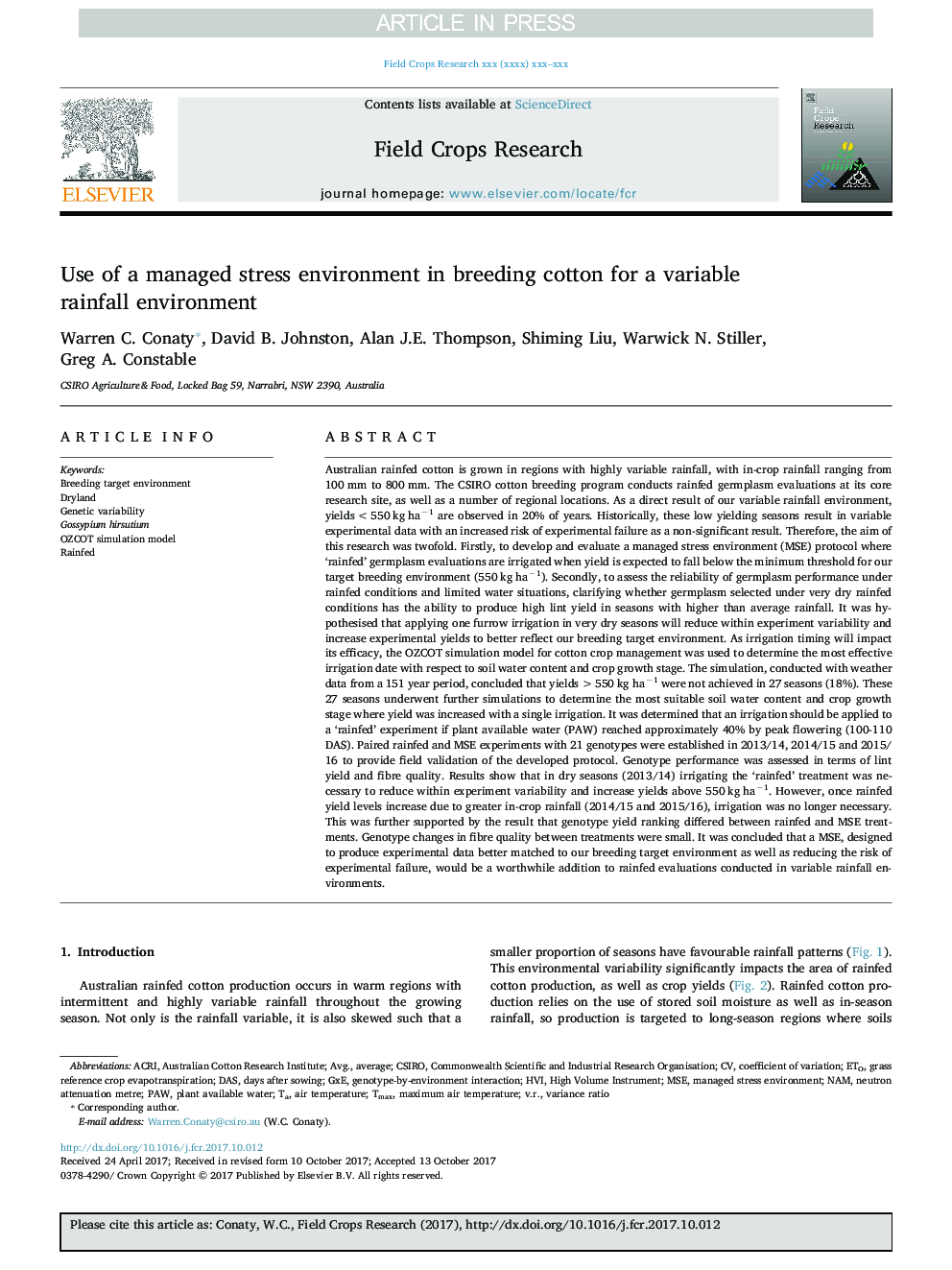| کد مقاله | کد نشریه | سال انتشار | مقاله انگلیسی | نسخه تمام متن |
|---|---|---|---|---|
| 8879267 | 1624642 | 2018 | 12 صفحه PDF | دانلود رایگان |
عنوان انگلیسی مقاله ISI
Use of a managed stress environment in breeding cotton for a variable rainfall environment
ترجمه فارسی عنوان
استفاده از یک محیط تنش مداوم در پرورش پنبه برای یک محیط بارندگی
دانلود مقاله + سفارش ترجمه
دانلود مقاله ISI انگلیسی
رایگان برای ایرانیان
کلمات کلیدی
maximum air temperatureEToDASMSERainfedCSIROPAWtmaxHVIGxE - GXEgenotype-by-environment interaction - اثر متقابل ژنوتیپ-توسط محیطGenetic variability - تنوع ژنتیکیAir temperature - دمای هواdays after sowing - روز بعد از کاشتCommonwealth Scientific and Industrial Research Organisation - سازمان تحقیقات علمی و صنعتی مشترک المنافعDryland - سرزمین خشکCoefficient of Variation - ضریب تغییرaverage - میانگینNAM - نامVariance ratio - نسبت واریانسPlant available water - گیاه آب در دسترس است
موضوعات مرتبط
علوم زیستی و بیوفناوری
علوم کشاورزی و بیولوژیک
علوم زراعت و اصلاح نباتات
چکیده انگلیسی
Australian rainfed cotton is grown in regions with highly variable rainfall, with in-crop rainfall ranging from 100 mm to 800 mm. The CSIRO cotton breeding program conducts rainfed germplasm evaluations at its core research site, as well as a number of regional locations. As a direct result of our variable rainfall environment, yields <550 kg haâ1 are observed in 20% of years. Historically, these low yielding seasons result in variable experimental data with an increased risk of experimental failure as a non-significant result. Therefore, the aim of this research was twofold. Firstly, to develop and evaluate a managed stress environment (MSE) protocol where 'rainfed' germplasm evaluations are irrigated when yield is expected to fall below the minimum threshold for our target breeding environment (550 kg haâ1). Secondly, to assess the reliability of germplasm performance under rainfed conditions and limited water situations, clarifying whether germplasm selected under very dry rainfed conditions has the ability to produce high lint yield in seasons with higher than average rainfall. It was hypothesised that applying one furrow irrigation in very dry seasons will reduce within experiment variability and increase experimental yields to better reflect our breeding target environment. As irrigation timing will impact its efficacy, the OZCOT simulation model for cotton crop management was used to determine the most effective irrigation date with respect to soil water content and crop growth stage. The simulation, conducted with weather data from a 151 year period, concluded that yields >550 kg haâ1 were not achieved in 27 seasons (18%). These 27 seasons underwent further simulations to determine the most suitable soil water content and crop growth stage where yield was increased with a single irrigation. It was determined that an irrigation should be applied to a 'rainfed' experiment if plant available water (PAW) reached approximately 40% by peak flowering (100-110 DAS). Paired rainfed and MSE experiments with 21 genotypes were established in 2013/14, 2014/15 and 2015/16 to provide field validation of the developed protocol. Genotype performance was assessed in terms of lint yield and fibre quality. Results show that in dry seasons (2013/14) irrigating the 'rainfed' treatment was necessary to reduce within experiment variability and increase yields above 550 kg haâ1. However, once rainfed yield levels increase due to greater in-crop rainfall (2014/15 and 2015/16), irrigation was no longer necessary. This was further supported by the result that genotype yield ranking differed between rainfed and MSE treatments. Genotype changes in fibre quality between treatments were small. It was concluded that a MSE, designed to produce experimental data better matched to our breeding target environment as well as reducing the risk of experimental failure, would be a worthwhile addition to rainfed evaluations conducted in variable rainfall environments.
ناشر
Database: Elsevier - ScienceDirect (ساینس دایرکت)
Journal: Field Crops Research - Volume 221, 15 May 2018, Pages 265-276
Journal: Field Crops Research - Volume 221, 15 May 2018, Pages 265-276
نویسندگان
Warren C. Conaty, David B. Johnston, Alan J.E. Thompson, Shiming Liu, Warwick N. Stiller, Greg A. Constable,
